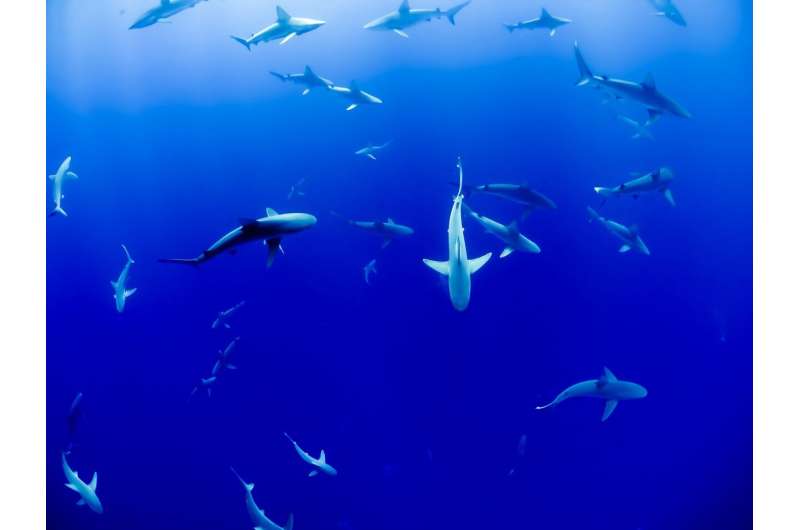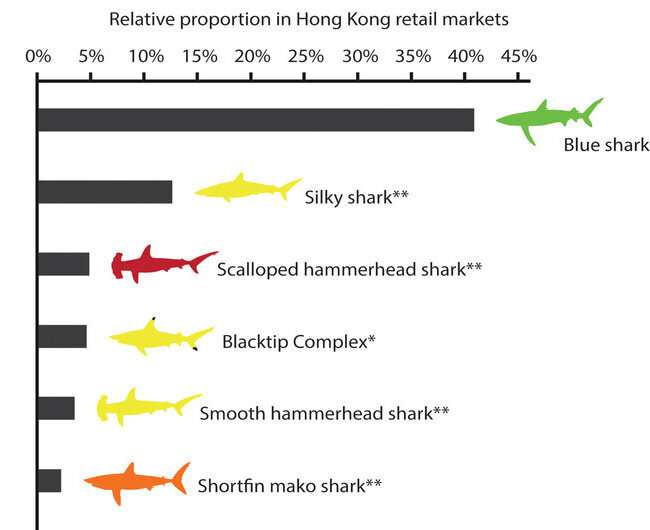

More than 70 percent of species that end up in the global shark fin trade are at risk of extinction—and sharks living closer to our coastlines might be of greatest conservation concern, according to new research.
A team of international scientists from the U.S. and China sampled 9,820 fin trimmings from markets in Hong Kong—one of the largest shark fin trade hubs in the world. With a little DNA detective work, they unraveled the mystery of which fins belonged to what shark species. In total, they found 86 different species. Sixty-one of those, more than two-thirds, are threatened with extinction. The research was recently published in Conservation Letters.
“Overfishing is most likely the immediate cause of the declining trends we are seeing in shark and ray populations around the world,” said Diego Cardeñosa Florida International University (FIU) FIU postdoctoral researcher and the study’s lead author. “The fact that we are finding so many species threatened with extinction in the global shark fin trade is a warning sign telling us that international trade might be a main driver of unsustainable fishing.”
The International Union for the Conservation of Nature (IUCN) Red List of Threatened Species assessed sharks—and their relatives, the rays and chimeras—in 2021 and found about one third of all species were threatened. Results of this new study indicate species in this trade are much more likely to be in threatened categories.
For nearly a decade, Demian Chapman—Director of the Sharks & Rays Conservation Program at Mote Marine Laboratory & Aquarium and Adjunct Professor at FIU—has led the collaborative team, that includes Cardeñosa, to track and monitor the global shark fin trade.

To date, they’ve conducted DNA testing on about 10,000 small scraps taken from processed imported fins, sold in markets in Hong Kong and South China. The project is in collaboration with BLOOM Association Hong Kong and Kadoorie Farm & Botanic Garden. The team’s goal is to better understand what species are in the trade and how common they are. By tracking this over time, they will be able to inform decision-makers about how well various management measures are working.
The study found the common species that end up in the fin trade are open ocean, or pelagic sharks, like the blue and silky sharks. However, the greatest number of species in the trade live in coastal areas, including blacktip, dusky, spinner and sandbar sharks. The researchers warn without management many of coastal species could become extinct. Three coastal species are already thought to be extinct—all in nations that did not regulate shark fishing.
“A few nations are protecting or sustainably fishing sharks and their relatives, but the majority are not for a variety of reasons” Chapman said. “Quite a few of the coastal sharks we found in the trade—such as smalltail, broadfin, whitecheek and various hound shark, river shark and small hammerhead species—are listed as Endangered or Critically Endangered and yet there are no regulations protecting them anywhere in their range. Unless the relevant governments respond with management soon, we are likely to experience a wave of extinctions among coastal sharks and rays.”
One way to encourage better species management is to list them under the Convention on International Trade in Endangered Species of Wild Fauna and Flora (CITES)—an international agreement seeks to protect animals and plants from overexploitation driven by international trade.
The 19th meeting of the Conference of the Parties (CoP19) to CITES takes place in November. This study will provide key evidence for deliberations by bringing the plight of costal sharks to the attention of governments and showing only a small percentage of the overall trade in shark fins is currently regulated under the Convention.

“At the upcoming CITES CoP19 Governments have tabled proposals that would bring the vast majority of sharks traded for their fins under the convention’s sustainability controls, action that has been informed by this study’s findings. We’re encouraged to see CITES Governments match their level of ambition to the level of threat seen for sharks and rays globally, with CITES listings a strong driver for better domestic management of shark fisheries,” said Director of Shark and Ray Conservation at the Wildlife Conservation Society Luke Warwick.
If these proposals are adopted, nations would be obliged to ensure that any export of listed species is legal, traceable and sustainable.
“There is a rage of management actions that nations can take to get coastal shark fishing under control and avert this extinction crisis,” Chapman said. “From changing fishing gear, to creating protected areas, to limiting catch, the solutions are out there.”
“Many of these coastal species are in the highest extinction risk categories. The next category is extinction,” Cardeñosa said. “We can’t allow this to happen.”
Silky sharks find hope in Atlantic, remain targets in Indo-Pacific
Diego Cardeñosa et al, Two thirds of species in a global shark fin trade hub are threatened with extinction: Conservation potential of international trade regulations for coastal sharks, Conservation Letters (2022). DOI: 10.1111/conl.12910
Florida International University
Citation:
Two-thirds of species in global shark fin trade at risk of extinction (2022, July 19)
retrieved 19 July 2022
from https://phys.org/news/2022-07-two-thirds-species-global-shark-fin.html
This document is subject to copyright. Apart from any fair dealing for the purpose of private study or research, no
part may be reproduced without the written permission. The content is provided for information purposes only.